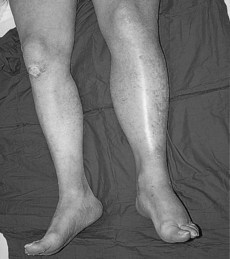216 Swollen leg I
Deep vein thrombosis
Salient features
History
• Recent history of immoblization including recent surgery, stroke, myocardial infarction
• Whether onset was acute or chronic
• Past and family history of thromboses including deep vein thrombosis (DVT), pulmonary embolism
• Drug history: oral contraceptives
• Air travel; the evidence is circumstantial (BMJ 2001;322:188).
Examination
• Unilateral swollen leg with pitting oedema (Fig. 216.1)
• Pain on the calf on dorsiflexion of the foot: Homans’ sign (not diagnostic).

Fig. 216.1 Deep venous thrombosis: acutely swollen left leg with dilation of the superficial veins.
(With permission from Forbes, Jackson 2003.)
• Check for pitting oedema on both sides (look at the patient’s eyes while eliciting this sign to ensure that you are not hurting the patient).
• Compare the temperature of both the legs (use the dorsum of your fingers to elicit this sign).
• Check the arterial pulses in the leg.
• Comment on the heparin pump by the bedside.
• Remember to collect your thoughts when asked to examine the legs: do not rush in to grab the patient’s legs.
Questions
What are the predisposing factors for venous thrombosis?
• Surgery (particularly of leg or pelvis, or after prostatectomy)
• Following cerebrovascular accident (about half of the patients develop DVT)
• Following myocardial infarction (one-third of patients have DVT)
• Malignancy (Lancet 1998;351:1077–80)
• Older age (exponential increase above the age of 50 years)
• Immobilization (paralysed limbs in stroke, paraplegia)
• Previous DVT (risk increases two- to three-fold)
• Pregnancy (risk increased in postpartum period)
• Hypercoagulable states: antithrombin III deficiency, protein C deficiency, protein S deficiency, antiphospolipid syndrome, excessive plasminogen activator inhibitor, polycythaemia vera, erythrocytosis



